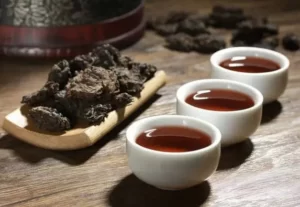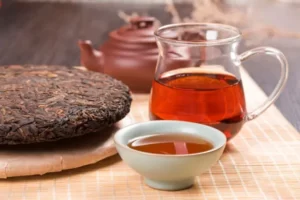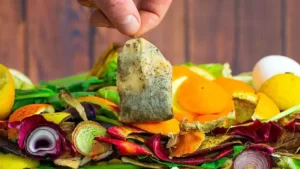Golden liquid poured, forming a frothy cascade of ivory bubbles. Effervescent and alive, the foam clung to the glass like delicate lace.
Don’t get me wrong, the above paragraph is not describing beer, but brewing rock tea.

For many tea enthusiasts, it is not uncommon to observe a layer of foam floating on the surface of rock tea when brewing it. Even after a few infusions, the foam persists. Is this a natural occurrence or a sign of harmful substances? What exactly is this foam? Today, let me provide you with some answers.
Tea Saponins
In ancient times, people noticed the formation of foam when brewing tea and regarded this foam as the essence of the tea. With advancements in scientific technology, researchers discovered that the substance responsible for the formation of foam during tea brewing is called tea saponin.
Also known as saponins or soapwort glycosides, tea saponins can produce long-lasting, soap-like foam when dissolved in water or agitated. They possess various beneficial properties, such as anti-inflammatory, analgesic, cough suppressant, expectorant, and antibacterial effects. Tea saponins are used in the treatment of geriatric bronchitis and various types of edema.
Tea saponins are natural glycosides found in plants of the Theaceae family. They are distributed in the roots, stems, leaves, and seeds of tea plants. In terms of saponin content, it is higher in older stems, followed by younger stems, older leaves, and younger leaves. Consequently, compared to tea varieties with higher plucking standards, such as young tea leaves, rock tea, pu-erh tea, or black tea made from older and coarser raw materials, tend to produce more foam when brewed.

Adhering Substances
Another reason why rock tea produces foam is the charcoal firing process it undergoes during production. In this process, alkaline substances released from the tea leaves combine with airborne particles, resulting in a white frost-like appearance on the tea surface. This phenomenon also contributes to the formation of foam.
However, some tea leaves may gather dust and impurities during processing and storage. When the brewing water flows rapidly into the teacup, it agitates these impurities, creating a considerable amount of foam.
While the foam formed during regular tea consumption poses no harm to our bodies, it is essential to be cautious of “dirty tea” contaminated with dust and impurities.
Therefore, if you encounter foam that appears dirty or even observe discoloration on the teacup lid while drinking tea, it is advisable to wipe off the foam before consumption.

Brewing Techniques
Additionally, the amount of foam also correlates with the height of the water flow during brewing. A higher water flow often leads to more foam. On the other hand, if the water is slowly poured along the inner wall of the cup, the foam in the tea can be significantly reduced. Those who enjoy drinking beer should understand this principle.
Apart from the factors mentioned above, brewing techniques can also influence the amount of foam produced when steeping rock tea. The temperature and duration of steeping, as well as the vessel used, can all play a role. Higher temperatures and longer steeping times tend to generate more foam, while using a covered teapot or gaiwan may trap the foam, resulting in a more concentrated layer on the surface.
Do I Need to Scrape Off a Layer of Foam When Brewing Rock Tea?
The presence of foam when brewing rock tea is not a cause for concern. It is primarily attributed to tea saponins, natural glycosides that produce persistent foam resembling soap bubbles. Additionally, the charcoal firing process during tea production contributes to the formation of foam, while dust and impurities may also generate foam during brewing. Although foam does not pose harm during regular tea consumption, it is essential to ensure the tea is clean and free from impurities. Therefore, whether you need to scrape off a layer of foam when brewing rock tea depends on your preference, after all, it does not affect health and taste. By understanding the nature of foam in rock tea, tea enthusiasts can fully appreciate its unique characteristics and enjoy a delightful tea-drinking experience.





